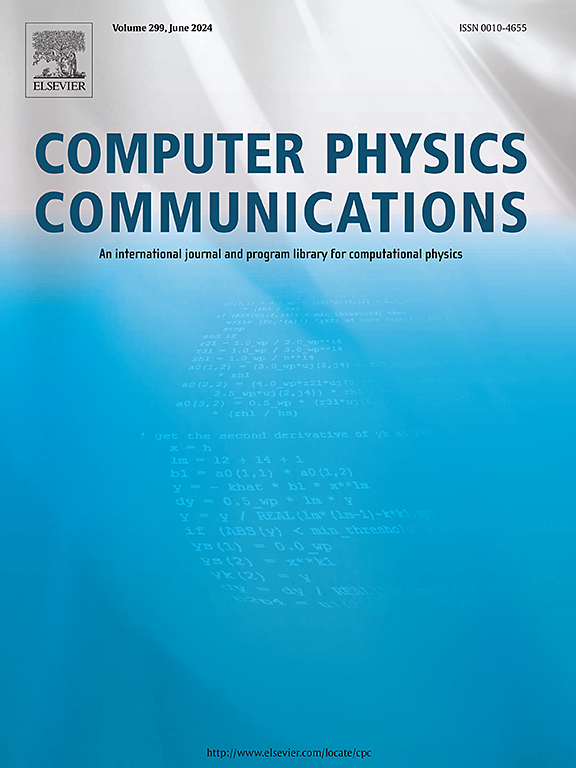用于超大时间投影室轨迹重建的卡尔曼滤波器
IF 7.2
2区 物理与天体物理
Q1 COMPUTER SCIENCE, INTERDISCIPLINARY APPLICATIONS
引用次数: 0
摘要
本研究介绍了一种卡尔曼滤波器,它是为均质气体时间投影室(TPC)量身定制的,改编自 ALICE 实验所使用的算法。为了描述垂直于磁场平面的半圆形轨迹,我们在卡尔曼滤波算法中引入了一种新颖的镜面旋转技术,从而能够有效跟踪不同长度的轨迹,包括那些在探测器内有多个圆形轨迹的轨迹,也称为 "环形轨迹"。电子动量分辨率提高了 80%,μ介子和先驱动量分辨率提高了 50%,这些都证明了这一改进的重要性。此外,相对较短的低动量 "环形器 "轨道的重建效率也有显著提高。这种进步不仅为 ALICE TPC 的未来带来了希望,而且也为中微子高压气体 TPC 带来了希望,由于中微子相互作用中产生点的随机性及其相对较低的能量,环形轨道变得非常重要。特别是,低能电子重构的改进(可能产生 "循环 "轨迹,新算法的影响已得到直接证明)会极大地影响通量测定的质量,而通量测定在加速器中微子实验中依赖于νe电子散射的测量。本文章由计算机程序翻译,如有差异,请以英文原文为准。
A Kalman filter for track reconstruction in very large time projection chambers
This study introduces a Kalman Filter tailored for homogeneous gas Time Projection Chambers (TPCs), adapted from the algorithm utilized by the ALICE experiment. In order to describe semi-circular paths in the plane perpendicular to the magnetic field, we introduce a novel mirror rotation technique into the Kalman Filter algorithm, enabling effective tracking of trajectories of varying lengths, including those with multiple circular paths within the detector, also known as “loopers”. Demonstrated relative improvements of up to 80% in electron momentum resolution and up to 50% in muon and pion momentum resolution underscore the significance of this enhancement. Significant improvements in the reconstruction efficiency for relatively short low momentum “looper” tracks are also shown. Such advancements hold promise not only for the future of the ALICE TPC but also for neutrino high-pressure gas TPCs, where loopers become significant owing to the randomness of production points and their relatively low energies in neutrino interactions. In particular, an improvement in low energy electron reconstruction, for which the production of “looping” tracks is likely and the impact of the new algorithm is directly demonstrated, could significantly impact the quality of flux determination, which in accelerator neutrino experiments relies on the measurement of electron scatterings.
求助全文
通过发布文献求助,成功后即可免费获取论文全文。
去求助
来源期刊

Computer Physics Communications
物理-计算机:跨学科应用
CiteScore
12.10
自引率
3.20%
发文量
287
审稿时长
5.3 months
期刊介绍:
The focus of CPC is on contemporary computational methods and techniques and their implementation, the effectiveness of which will normally be evidenced by the author(s) within the context of a substantive problem in physics. Within this setting CPC publishes two types of paper.
Computer Programs in Physics (CPiP)
These papers describe significant computer programs to be archived in the CPC Program Library which is held in the Mendeley Data repository. The submitted software must be covered by an approved open source licence. Papers and associated computer programs that address a problem of contemporary interest in physics that cannot be solved by current software are particularly encouraged.
Computational Physics Papers (CP)
These are research papers in, but are not limited to, the following themes across computational physics and related disciplines.
mathematical and numerical methods and algorithms;
computational models including those associated with the design, control and analysis of experiments; and
algebraic computation.
Each will normally include software implementation and performance details. The software implementation should, ideally, be available via GitHub, Zenodo or an institutional repository.In addition, research papers on the impact of advanced computer architecture and special purpose computers on computing in the physical sciences and software topics related to, and of importance in, the physical sciences may be considered.
 求助内容:
求助内容: 应助结果提醒方式:
应助结果提醒方式:


